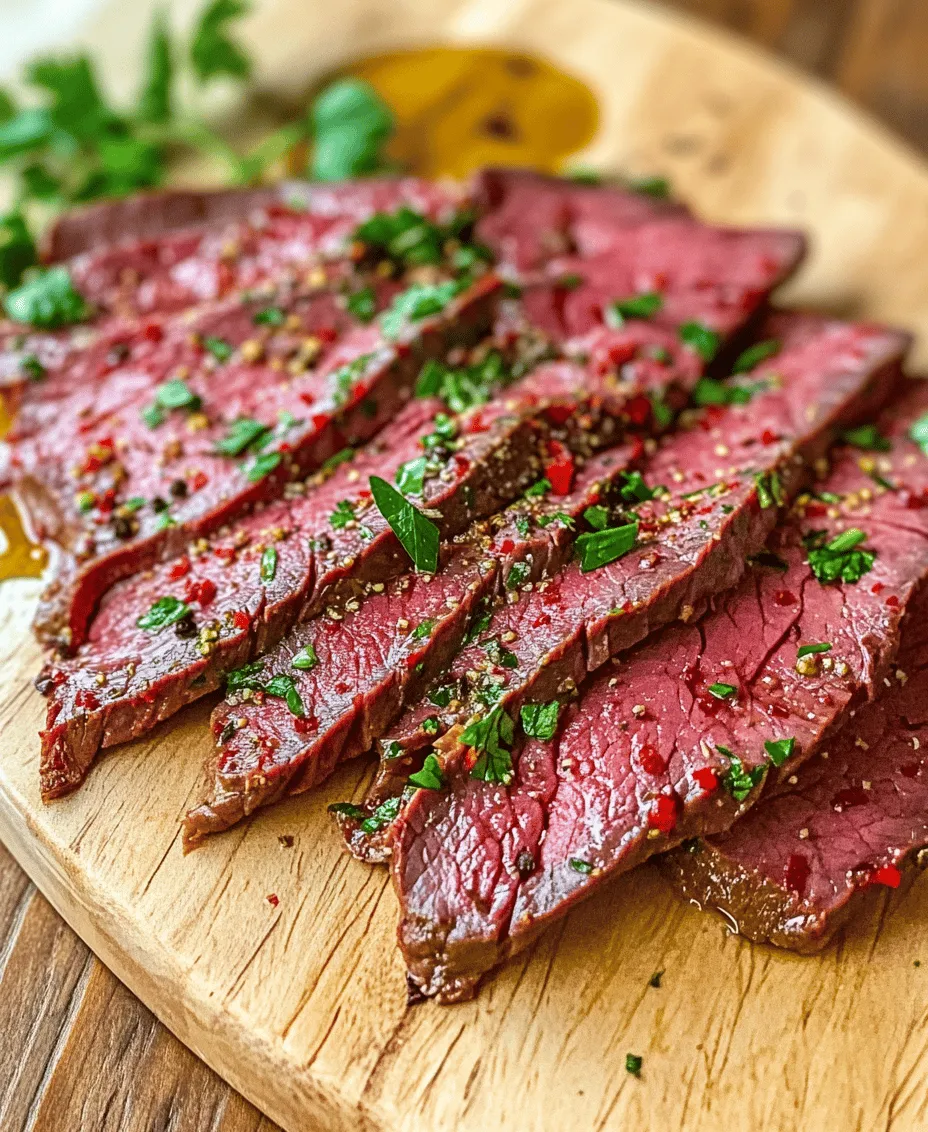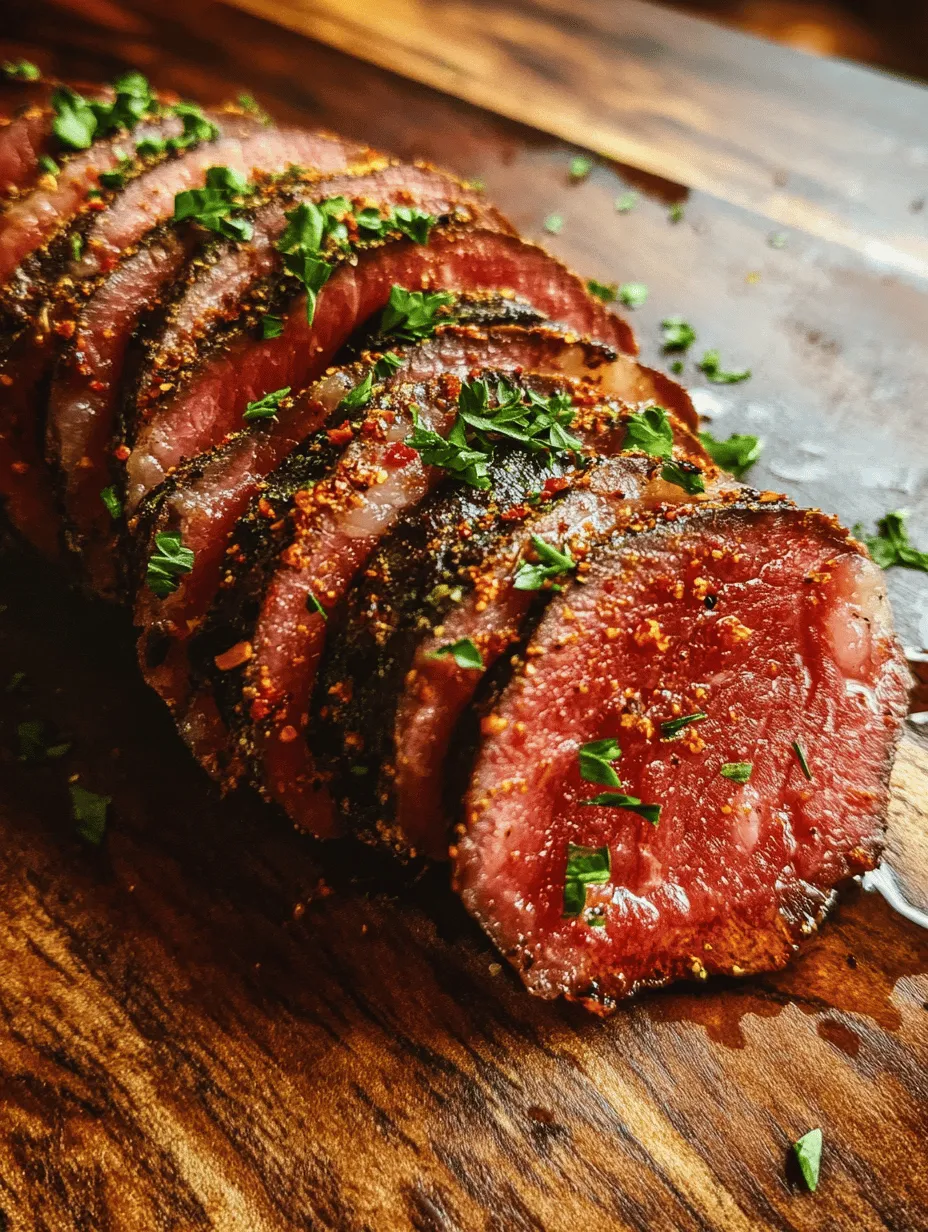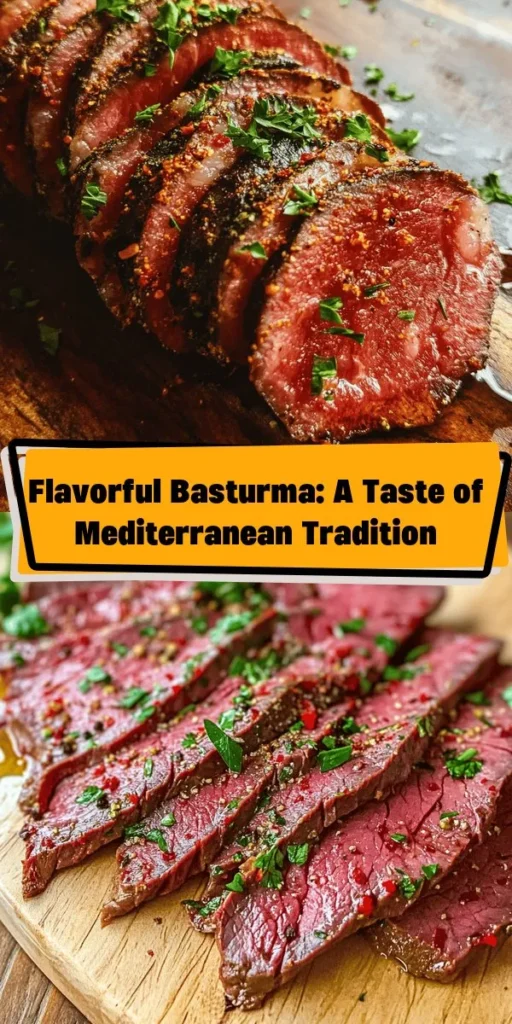Introduction
Basturma, a traditional cured meat delicacy, takes us on a flavorful journey through the Mediterranean and Middle Eastern culinary landscapes. This ancient recipe embodies a rich heritage, where the art of preserving meat through spices and time transforms simple ingredients into a gastronomic delight. As one of the oldest forms of food preservation, Basturma showcases the ingenuity of our ancestors in utilizing the resources available to them, resulting in a dish that is not only delicious but also steeped in history.
In this article, we will explore the preparation of Basturma Delight, examining its origins, cultural significance, and the meticulous process involved in crafting this flavorful dish. Whether you are a seasoned chef or a curious food enthusiast, you will find the step-by-step instructions and insights into the ingredients essential to creating your own Basturma in the comfort of your kitchen.
Understanding the Art of Basturma: A Culinary Journey
The Origins and Cultural Significance of Basturma
Exploring the Historical Roots of Basturma
Basturma’s history dates back centuries, with roots tracing back to ancient civilizations in the Mediterranean region. While its exact origin is still debated, it is widely believed that the process of curing meat was developed as a means of preservation before the advent of refrigeration. The word “Basturma” is derived from the Turkish word “bastırma,” which means “to press,” referring to the method by which the meat is cured and preserved.
In its earliest forms, Basturma was made using various cuts of meat, typically beef, and was seasoned with a blend of spices that not only enhanced its flavor but also provided antimicrobial properties, ensuring the meat could be stored for extended periods. Over time, this dish became a staple in many Middle Eastern and Mediterranean countries, where it evolved into various regional interpretations, each with its unique twist on flavors and spices.
Culturally, Basturma holds a significant place in celebrations and family gatherings. In many countries, it is enjoyed during festive occasions, special meals, and communal celebrations, serving as a symbol of hospitality and tradition. The preparation of Basturma often involves family and friends, emphasizing the communal aspect of cooking and sharing food together. As such, it is more than just a dish; it is a representation of heritage, craftsmanship, and the joy of gathering around a table.
Variations of Basturma Across Different Regions
While the fundamental concept of Basturma remains consistent, its variations highlight the diversity of culinary practices in different regions. In Greece, for example, you may find Basturma flavored with a blend of spices that includes coriander and allspice, lending it a distinct aromatic profile. In Armenia, the preparation involves a unique combination of crushed garlic and fenugreek, which is integral to the flavor of their Basturma.
Each region has its own flair, influenced by the local ingredients and culinary traditions. This diversity not only enriches the dish but also tells the story of the people who have embraced it throughout history. As you embark on your journey to make Basturma Delight, you will appreciate the artistry and culture behind this time-honored recipe.
Understanding the Ingredients of Basturma Delight
The Essential Components of Your Basturma
To create a truly authentic Basturma, selecting the right ingredients is crucial. Each component plays a vital role in both the flavor and texture of the final product. Here are the essential elements you will need to prepare your Basturma Delight:
1. Beef Tenderloin or Round: Choosing the right cut of beef is the first step towards achieving optimal flavor and tenderness. Beef tenderloin is a prime choice due to its rich taste and melt-in-your-mouth texture, while beef round offers a more robust flavor. Regardless of your choice, ensure the meat is fresh and of high quality, as this will significantly impact the final result.
2. Crushed Garlic: Garlic is not just a flavor enhancer; it also acts as a preservative, contributing to the longevity of the cured meat. The pungent aroma and taste of crushed garlic will infuse the meat, creating a savory base for your Basturma.
3. Fenugreek Seeds: Fenugreek seeds are a hallmark of Basturma, providing a unique aromatic depth to the dish. Toasting and grinding the seeds before use will unlock their full flavor potential, adding a warm, slightly nutty essence to your cured meat.
4. Paprika and Sea Salt: The combination of paprika and sea salt is essential for the curing process. Paprika not only adds color but also contributes a mild sweetness and smokiness, while sea salt acts as a preservative, drawing moisture from the meat and preventing spoilage.
5. Black Pepper and Cayenne: The balance of spices allows you to tailor the heat level of your Basturma to suit your personal preference. Black pepper adds a gentle warmth, while cayenne can be adjusted to bring in a kick of heat if desired.
6. Olive Oil and Fresh Parsley: As finishing touches, olive oil provides a rich, velvety mouthfeel, while fresh parsley adds a burst of color and freshness. These elements elevate the dish, enhancing both its flavor and presentation.
Step-by-Step Preparation of Basturma Delight
Now that you understand the origins and significance of Basturma, as well as its essential ingredients, it’s time to dive into the step-by-step preparation of your Basturma Delight. This process requires patience and attention to detail, but the results are undeniably rewarding.
1. Selecting and Preparing the Meat: Start by choosing a high-quality cut of beef. If using beef tenderloin, trim any excess fat to ensure a leaner final product. For beef round, ensure it is cut into a uniform size to promote even curing.
2. Creating the Marinade: In a mixing bowl, combine crushed garlic, toasted and ground fenugreek seeds, paprika, sea salt, black pepper, and cayenne. This mixture will serve as the marinade for your meat. Ensure the spices are well-mixed to distribute the flavors evenly.
3. Marinating the Meat: Rub the spice mixture generously over the surface of the beef, ensuring every inch is coated. Place the seasoned meat into a resealable plastic bag or an airtight container, and refrigerate for 3 to 4 days. During this time, the salt will penetrate the meat, drawing out moisture and allowing the flavors to develop fully.
4. Drying the Meat: After the marination period, remove the beef from the refrigerator and rinse off any excess marinade under cold water. Pat the meat dry with paper towels. This step is crucial as it prepares the surface of the meat for the next stage of curing.
5. Coating with Spices: In a small bowl, combine additional paprika and crushed fenugreek seeds. Roll the dried meat in this spice mixture, ensuring it is thoroughly coated. This not only enhances the flavor but also creates a protective layer during the curing process.
6. Curing the Basturma: Hang the coated meat in a cool, dry place with good air circulation, or use a dedicated drying chamber if available. Ideally, the temperature should be around 50-60°F (10-15°C) with moderate humidity. Allow the meat to cure for 2 to 3 weeks, depending on your desired level of dryness.
As you embark on the preparation of Basturma Delight, keep in mind that the journey requires patience, but the reward of savoring this exquisite cured meat will be well worth the effort. The process is a celebration of culinary tradition, and by creating your own Basturma, you connect with a rich history that spans generations. Stay tuned for the next part of this article, where we will delve deeper into the nuances of this incredible dish and share tips for serving and enjoying your homemade Basturma Delight.

Preparing the Meat
To achieve the best results with your Basturma Delight, selecting and preparing the right cut of beef is essential. Traditionally, basturma is made with a lean cut of beef, such as eye of round or sirloin. These cuts are chosen for their low fat content, which allows for a better curing process and results in a firmer texture.
Trimming the Beef:
1. Start by placing the beef on a clean cutting board. Use a sharp knife to trim off any visible fat and connective tissue. This step is crucial because excess fat can lead to spoilage during the curing process.
2. Once trimmed, cut the beef into thick steaks, approximately 1 to 1.5 inches in thickness. This thickness balances the curing time and the final texture of the basturma.
Cutting for Curing:
1. After cutting the steaks, you can further slice them into uniform pieces that will allow for even curing. Each piece should ideally be about 4 to 6 inches long. Uniformity in size ensures that each piece cures at the same rate, resulting in consistent flavor and texture.
2. Once cut, place the beef pieces in a clean, non-reactive container, ready for the curing process.
Toasting and Grinding Fenugreek Seeds
Fenugreek seeds play a pivotal role in the flavor profile of Basturma. Toasting enhances their aroma and taste, making the final product more delightful.
Techniques for Toasting:
1. Begin by placing a skillet over medium heat. Add the fenugreek seeds to the dry skillet without any oil.
2. Toast the seeds for about 2-3 minutes, stirring frequently to avoid burning. You will know they are ready when they become fragrant and slightly darker in color.
3. Once toasted, remove the skillet from heat and allow the seeds to cool for a few minutes.
Grinding the Seeds:
1. Transfer the cooled fenugreek seeds to a spice grinder or mortar and pestle. Grind until you achieve a fine powder. If using a mortar and pestle, take your time to ensure an even consistency.
2. Set the ground fenugreek aside as you prepare to make the spice paste.
Making the Spice Paste
The spice paste is the heart of Basturma, infusing the beef with rich flavors that define this traditional dish.
Combining Ingredients:
1. In a bowl, combine the ground fenugreek with garlic powder, ground black pepper, and paprika. Adjust the quantities according to your taste preferences.
2. Add salt to the mixture; it’s essential for both flavor and preservation. Use high-quality sea salt or kosher salt for the best results.
3. Slowly add olive oil to the dry ingredients, mixing until you achieve a thick paste. The olive oil not only helps in binding the spices but also provides moisture during the curing process.
4. Ensure that the spice paste is well-combined and has a consistent texture, making it easier to apply to the beef.
Curing Process
Curing is where the magic happens. It transforms the raw beef into the flavorful, preserved delicacy known as basturma.
Importance of Refrigeration:
1. Rub the spice paste generously over each piece of beef, ensuring that every surface is well-coated. The spice paste must adhere well for effective curing.
2. Place the coated beef pieces in a container, cover with plastic wrap, and refrigerate. This step allows the salt to draw moisture out of the meat, essential for proper curing.
3. For the first three days, turn the beef daily. This ensures that the spice paste evenly penetrates the meat and that moisture is consistently drawn out.
Air Drying the Beef
After the curing period, the next step is air drying, which is vital for developing the perfect texture and flavor.
Best Practices for Hanging and Drying:
1. Remove the beef from the refrigerator after three days. Rinse each piece under cold water to remove excess salt and spice paste, then pat them dry with paper towels.
2. Using a clean butcher’s twine, tie each piece of beef securely. Hang the beef in a cool, dry, and well-ventilated area, preferably at a temperature of 60-70°F (15-21°C).
3. Allow the beef to air dry for at least 2-3 weeks. The drying time can vary based on environmental conditions. The goal is to achieve a firm texture without any moisture remaining inside.
The Science Behind Curing Meat
Understanding the mechanics of meat preservation can enhance your appreciation for the basturma-making process.
The Role of Salt:
Salt plays a crucial role in the curing process. It draws moisture out of the meat, creating an environment where bacteria cannot thrive. This not only preserves the meat but also intensifies the flavors.
How Spices Contribute:
Spices not only enhance flavor but also provide antimicrobial properties. Fenugreek, garlic, and paprika work together to create a flavor profile that is both complex and delightful.
Importance of Air Circulation:
Air circulation during the drying process is crucial for preventing spoilage. Proper airflow ensures that the beef dries evenly and helps develop the characteristic texture of basturma.
Serving Suggestions for Basturma Delight
Elevating your basturma experience goes beyond just the curing process; how you serve it can enhance its flavors and your guests’ enjoyment.
Best Practices for Slicing and Presenting:
1. Use a sharp knife to slice the basturma into thin, even pieces. Slicing against the grain will yield a more tender bite. Aim for slices that are about 1/8 to 1/4 inch thick.
2. Present the slices on a wooden or slate board for a rustic touch. This not only looks appealing but also allows for easy serving.
Pairing Suggestions:
Basturma pairs beautifully with a variety of sides and beverages. Consider serving it alongside:
– Fresh bread or pita for a delightful contrast.
– Pickled vegetables to add a tangy element.
– Cheese platters featuring sharp cheeses that complement the savory notes of the basturma.
– Red wine or a robust beer, which can enhance the overall tasting experience.
Creative Ways to Incorporate Basturma:
Basturma is versatile and can be incorporated into various dishes:
– Use it as a flavorful addition to salads, giving them a unique twist.
– Add basturma to pasta dishes for an unexpected savory kick.
– Incorporate it into breakfast by adding slices to omelets or frittatas.
Conclusion
Basturma Delight is more than just a recipe; it’s a celebration of tradition, flavor, and craftsmanship. By embarking on the journey of making your own basturma, you not only connect with the rich history of this dish but also bring a unique and delicious element to your dining table. Whether enjoyed as an appetizer or incorporated into a main course, basturma is sure to impress and satisfy those who partake in its savory embrace. The meticulous process of curing and drying the beef transforms simple ingredients into a culinary masterpiece, inviting you to share in a tradition that spans generations. Enjoy the fruits of your labor and savor the delightful flavors of homemade basturma.



